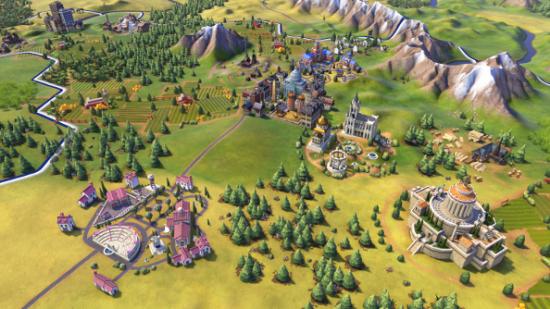Civilization VI, despite only being announced this month, is rapidly approaching its October launch. I got to spend 60 turns building my Chinese empire recently, fighting the treacherous Teddy Roosevelt and building lovely wonders, and it left me with plenty of questions.
Here’s everything we know about Civilization VI so far.
Thankfully, lead producer Dennis Shirk was on hand to spill the beans on the new art style, espionage, and how secret leader agendas work.
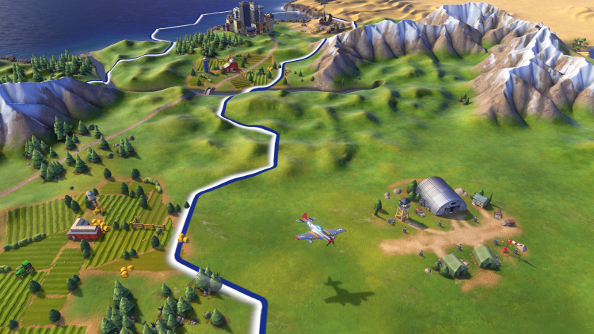
PCGN: When the first screenshots were released, some folk didn’t know what to make of Civ VI. It’s very different from the previous game – what were your goals with the new aesthetic?
Dennis Shirk: It’s nice because we’re watching the fans have the debate. I understand why there’s consternation, because if you have a fan who spends 500 to a thousand hours in Civ V, when we have a big change like that, it’s going to be startling.
Obviously, you’ve heard about unstacking the cities. With Civ V, Civ IV, Civ Revolution, everything goes in the middle, you need no readability on the map because everything that goes on that map is going to be the farms, the trading posts, the mines. It doesn’t matter as much, but if we take out 60, 70… however many buildings there are in the games across 12 districts and three or four or however many buildings per district, we needed massive readability. Whether it was zoomed out or in, we needed players to be able to see what’s going on with their civ without having to mouse over everything to see that it’s a library.
Everything is readable, every building has been modelled, everything is themed – by colour, by style – so say you’re walking by another civilisation, he’s got a campus built and all the roofs on the campus building – the library, the university, the research lab – are blue, they tie in with the blue colour of the icon, the guild. The theatre square which is a culture district has magenta roofs, magenta details. It’s gold for the commercial hub. Everything is readable and every building is instantly recognisable, and because we stylized everything we were able to do that. We took out a lot of the noise in the terrain.
We took a lot from what we thought was successful from the past games – Civ IV was very iconic because you could see the individual trees and the buildings that were in the city, Civ Rev had the living, bright colour palette, and Civ V had the detail that we were looking for. We took those and made everything readable… One thing with Civ V is that late game can get a little messy. Everything is filled up and readability is not a strong point. That’s not the case with the late game of Civ VI. You still understand exactly what’s going on with your map.
From the aesthetic point of view when you start messing around with the time of day and when the wonder reveals happen – when it goes from nighttime to daytime and we see the lights change and the shadows move and the buildings light up – those things wouldn’t be possible with the aesthetic chosen for Civ V. It was gritty and you wouldn’t be able to pull that life out of it. Whether it’s zoomed in up close where you can see every detail – the rocks, the birds – or whether you pull it back far away, you know what’s going on in the world.
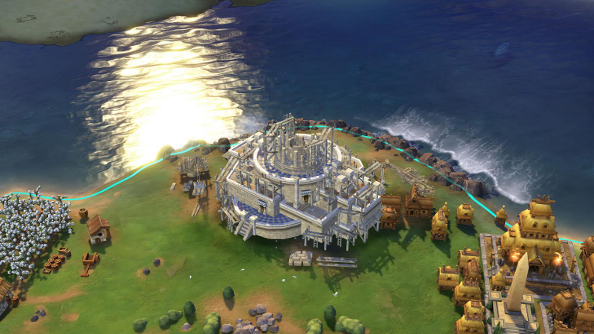
So if you’re commanding an army, roaming around and looking for a nice target, you can, within a second, understand what the city you’re about to prey on has.
And that’s important because it means you’re not just heading for the city centre as before, it’s a matter of: do I want to deprive them of science, do I occupy their campus or do I burn it to the ground? Or it’s the encampment, where is it? I need to find it. You also know what every unit looks like, they’re shaped differently, we made them a little bigger.
There are big changes with the UI as well. I noticed all those nestled menus – again, are you trying to remove clutter?
We are to a degree, and I can say that the UI is still going to look a little different from how you’re seeing it. There are a lot of placeholders, things we’re trying out that may or may not work. Generally we’re trying to keep the game in the map. We didn’t want to frame in the city screen anymore where you get taken away from the world.
Every decision needs to matter. If you’re clicking into a city, you’re looking at the terrain now, because before you were kind of looking for resources, but the decision wasn’t as interesting as it is now, especially with adjacency bonuses. Your city specialisation will count based on where you place that city: mountains mean you’re going to be faith heavy or science heavy; if you’re near a coast it’ll be a harbour or commercial hub.
When I put my first city down as China, I could already imagine how it would be built up, because it’s got mountains on one side and I immediately got my boost to sailing as well, by being on the coast – are all of these tech boosts known straight away, they’re never hidden?
No, they’re never hidden, and what’s nice is that influences how you play. If you’re playing a certain way it actually rewards you to keep playing that way if you want, or you can change direction. If you’re playing a heavy military game and you’re clearing barbarian camps and conquering stuff you’re most likely earning boosts to more similar tech further down the line because it’s what you’re already doing, so it feels very real-world because it’s reinforcing what you’re already doing.
Why make builders exhaustible? Is it to keep things less cluttered so you’ve not got 40 workers at one time?
We never liked the idea that the worker you built in 4,000 BC is the same one you have in the modern era. Aside from that, when you’re playing this puzzle game of where do I put stuff and what’s the best place for it, the improvement [of hexes] was probably the lowest tier of things we wanted the player to be concerned with.
So making the builder part the simplest approach – it’s something you have to produce, you have to make a new builder once you’ve expended them, it’s a decision you have to make in your build queue, then you’re worrying about placement and time and everything else – Ed [Beach, lead designer] wanted to try that, and it was a win. It was one of the first things we put into the game. There’s no more select builder, click automate and forget about them, because that’s not an interesting decision. This makes a whole series of interesting decisions. At first when you’re playing the Civ V mentality is just improve everything you can, here you don’t necessarily want to do that, because you’re wasting charges if you do that. And if you do decide to build something over your improvement, if you’re a micro player you’ve just lost all that production from the builder.
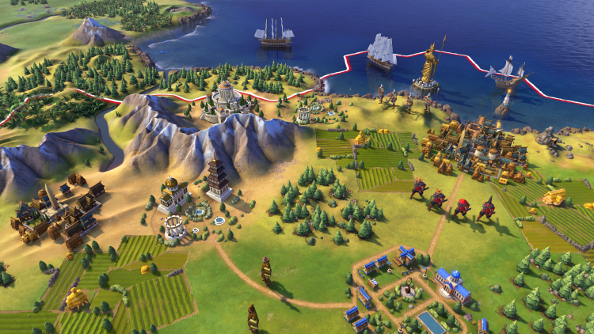
I’ve been trying to play peacefully, but I’ve seen people getting into wars with Cleopatra by turn 20.
She has a historical agenda where if you’re weak she hates you.
If Cleopatra turns on me, if she’s got units besieging my city and choosing these different targets, can she destroy my wonders?
Wonders are the one thing that we never wanted to damage or destroy. I know horrible things can happen to a wonder in the real world, but it’s one thing we wanted to shield people from: having smoking ruins of the Pyramids. We imagine that everyone in the world has such respect for a wonder that they wouldn’t destroy one.
Wonder placement is important now as well, so for example you can only build the Pyramids on a desert hex…
Yes. Not only does that add the historical flavour, it keeps everything new. So depending where you’re at you might want the Pyramids, but your starting position won’t let you get them. It’s why scouting is so important in this game. You have to look at everything and once you have the lay of the land, you start planning where everything is going to go. Maybe you see a patch of desert and go, ok, that’s what I need because I really want to build the Pyramids. Making these wonders have requirements adds a whole new dimension in terms of replayability: you can’t come in a do the same set of buildings again, you can’t do the same stuff. The terrain and world dictate your path.
I know the historical agendas, like Cleopatra’s hatred of weakness, are set, but what about the secret agendas – are they entirely random?
There’s a whole set of random agendas that we’ve added into the game – and I’m curious to see how modders expand that. You’ve got the historical one, that’s who they are, that’s their flavour. But every one of them, depending how far into the game they go, their random agenda will activate too. Depending on who you’re playing and who they’re up against, they might get angry at you and you might not know why. Maybe you set up a trade route and get some gossip coming out of the trade route saying why they might be angry at you or what’s going on. Maybe you’ll send spy at you later in the game.
For example, Teddy Roosevelt likes a peaceful continent, but his random agenda might be that he covets wonders, he wants to have the most wonders. You have more, and you’re going to discover that he’s really angry about that to the point where he’s going to war over it. The trick is to find out why – you’re going to see the modifier, see that there’s an unknown reason. So espionage is actually game-long. It’s not called espionage early on, it’s called gossip – it’s the connections you make, you’ll get bits of information coming back.
There are a tremendous amount of random agendas, whether it’s your level of industry, science, culture generated, whether you have more luxuries than somebody else, so they’re coveting that. There’s a lot of different things in play that makes each game interesting. The historical agenda is always going to be the dominant one, but the random agenda adds a whole different level each time you play it. In Civ V Montezuma plays the same every time.
He’s always a dick
He’s always a dick. But now he might be a dick, but because of some random thing you might be doing, he might think you’re not such a bad guy and he’ll go be a dick somewhere else.
Speaking of espionage, it was a surprise to see that and religion already implemented, given that they weren’t part of the Civ V base game.
Coming out of the expansions, we didn’t want to take that step back. We want fans to come in, regardless of the new stuff we’re putting in, we want to make sure the majority of what they had before, they’ll still have. We didn’t want to run into a situation where no matter what new stuff we added, they’d be like “Where’s religion? Where’s espionage?” We didn’t want that.
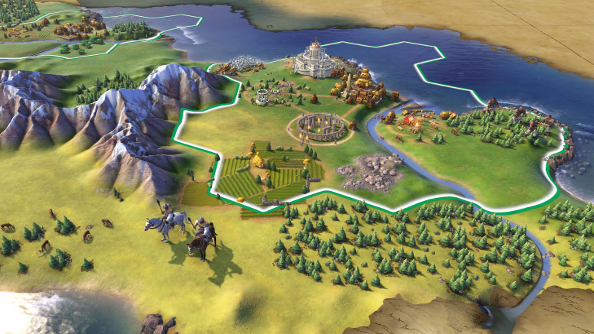
You’ve got two tech trees now, with the civic tree and the regular research – why split them?
Are you a builder or a conqueror?
I’m a builder, but sometimes I like to have a tantrum.
I think in the same way. In Civ V, as a builder you’d go tall, it wasn’t a very good strategy to go wide. We wanted to remove the limitation that builders always go tall and tech goes wide, so we removed global happiness and made local happiness instead. So if you want to put a city up in the tundra because it has iron, they’re not going to be happy, but it’s a mining town, of course they’re not going to be happy. So you can do that now. That’s good, because if you’re a culture player the last thing you want to do is be in a game with a science happy civ that’s also militaristic. They’re going to tech so far, and you’re not going to go nearly as far because you’re going culture heavily, and they’re probably going to invade and destroy you while you’re trying to build your museums as stuff.
Ed wanted to branch that out. If you’re that culture player, the more culture you have, the further down the civics tree you’re going, instead of going down the tech tree – you’re still going through the eras. What you have as the civics player is the power of governments and policies. These give you a whole lot of flexibility against a technological and superior neighbour. So, if he’s going in with tanks, you’re going to slot in different policies that produce a better defence and then you’ll be able to produce units faster. You might have lower tech units but you’ll have a lot more of them. You’re going to maybe slot in a policy that reduces your unit maintenance by half so you can have a bigger army even though it’s lower tech.
So you can impress the world by having a super advanced government system. So it’s just kind of a parallel universe for you to live in as a culture player, to be able to conquer and win the game and still advance through the ages. You’re not gonna be there with your spearmen when they’re coming in with infantry, or maybe you will, there’s still a possibility of that. But we wanted to make that alternate path. A Science player is never going to have that many policies or an advanced government to allow him to slot more policies in, while you’re going to have more more city-state friends as a result because there are a lot of powerful city state policies. You’ll have a lot more allies, while he’s busy conquering and getting everyone angry with him.
Civilization VI is expected to arrive on October 21.
